Nature Conservation 2025 — 31. 7. 2025 — Nature and Landscape Management — Print article in pdf
Dolní Kralovice Serpentinites – Restoring a Botanical Gem
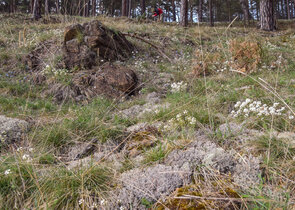
The Dolní Kralovice serpentinites are located in the eastern part of the District of Benešov (Central Bohemia). The serpentinite body is relatively extensive, being 3.5 km long and 1 km in width. About half of the area is protected as the Hadce u Želivky National Nature Monument (NNM) and the Želivka Site of European Importance (SEI, pursuant to Act No. 114/1992 on Nature Conservation and Landscape Protection, as amended later, the term for Site of Community Importance, SCIs, later Special Area of Conservation, SACs, under the European Union’s Habitats Directive), while the other half is part of a commercial forest. Since 2016, restoration of the entire site has been underway, with the aim of harmonising management both within the above Specially Protected Area and beyond it. Discussions are also ongoing with the owner, Forests of the Czech Republic, state enterprise, regarding transfer of land outside the SEI to special purpose forests.
Serpentinite as a distinctive rock type
Serpentinites are metamorphosed ultrabasic rocks that contain significant amounts of iron and magnesium, trace amounts of heavy metals (nickel, chromium, cobalt), but a lack of essential nutrients, including calcium. The high presence of magnesium and heavy metals can have a toxic effect on plant growth (Homer et al. 1991). Serpentinites are dark in colour, making them highly heat-retentive. They are also characterised by very slow weathering, which is why exposed ridges, sharp rock outcrops, and steep rocky slopes are often found there. The soils are typically very shallow and skeletal, quickly draining water, which easily flows away over the parent rock. This leads to increased erosion, nutrient leaching, and a more pronounced influence of the parent rock’s chemistry. As a result, plants are also exposed to another stress factor – drought (Lazarus et al. 2011). Due to their specific properties, such as toxicity, nutrient deficiency, and drought, serpentinite sites provide an inhospitable habitat for plant growth. However, certain plants have managed to adapt to these conditions (e.g. Brady et al. 2005; Anacker 2014; Arnold et al. 2016). There, many (sub)endemic plant species can also be found, such as the sandwort species Minuartia smejkalii, the Sandwort-leaved mouse-ear (Cerastium alsinifolium), and the Serpentine knautia (Knautia serpentinicola), as well as subspecies of the Alpine cinquefoil (Potentilla crantzii subsp. serpentini) and the Carthusian pink (Dianthus carthusianorum subsp. capillifrons). The vegetation there is different from its surroundings, with transitions that can sometimes be very abrupt (1–2 metres).
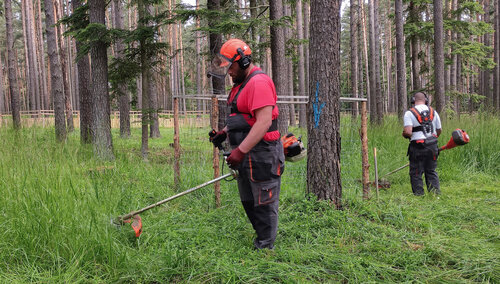
At sites where grazing was not possible, alternative management was introduced – mowing. © Hana Pánková
Species richness of the Dolní Kralovice serpentinites
The Dolní Kralovice serpentinites are among the most important serpentinite sites in the Czech Republic. On the serpentinite outcrops, we can encounter the endemic sandwort species Minuartia smejkalii, which has become an area’s flagship species. Among other critically endangered species found there are, for example, a subspecies of the Alpine cinquefoil (Potentilla crantzii subsp. serpentini), the Narrow-leaved forget-me-not (Myosotis stenophylla), the Short-winged bitter milkwort (Polygala amara subsp. brachyptera), and the Carthusian pink. In addition, several critically endangered species (C2) occur there, such as the Serpentine spleenwort (Asplenium cuneifolium). Of regional (subnational) importance, the Alpine pennycress (Thlaspi montanum) and the Moravian bedstraw (Galium valdepilosum) are also worth mentioning. Particularly unique is the coexistence of several contrasting vegetation types: crevice vegetation of serpentinite rocks and screes on steep slopes, and serpentinite peri-alpidic (biogeographically related to the periphery of the Alps) Sesleria pine woodlands. On the slopes with a northern to western aspect, which are more shaded and humid, the Sesleria pine woodlands are dominated by the Blue moor grass (Sesleria caerulea), with the Alpine pennycress occurring in great abundance. On the south- to south-east-facing, directly sunlit rocks, pine woodland occurs with abundant xerophytes, often dominated by grasses such as the Sheep’s fescue (Festuca ovina), Meadow oat-grass (Helictotrichon pratense), and the Purple-stem cat’s-tail (Phleum phleoides). On the driest open patches, terrestrial lichens form more extensive stands. A total of 156 species of lichens and lichenicolous fungi have been recorded in the area, including the critically endangered Star-tipped reindeer lichen (Cladonia stellaris). The site is a rich habitat for fungi, with particularly important communities associated with oligotrophic, basic soil substrates – for example, species of the genus Cortinarius (webcaps). Also noteworthy is the occurrence of 29 butterfly species and 194 moth species. The most interesting findings include the Wood white butterfly (Leptidea sinapis), which is associated with glades in open serpentinite pine woodlands. Of the recorded xylophagous species, the discovery of the critically endangered ‘primeval forest relict’ Nothorhina muricata (a longhorn beetle) is particularly significant. This very rare species depends on sunlit trunks of old pine trees growing outside closed forest stands.
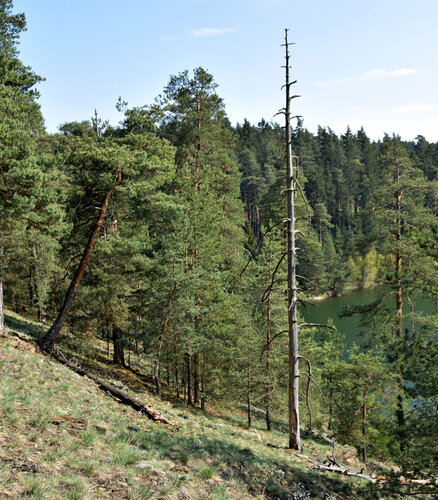
Vegetation on the steep slopes in the Hadce u Želivky National Nature Monument is formed by peri-Alpidic pine woodland. © Hana Pánková
Adverse impacts caused by human activity
The most significant human impact was the construction of the Švihov Water Reservoir, which flooded most of the rocky outcrops, along with the building of the D1 motorway through the most valuable site’s parts. A working serpentinite quarry is also located on the periphery of the area. Despite these negative impacts, high-quality serpentinite communities have been preserved across most of the site. Unfortunately, these human activities have resulted in the artificial fragmentation of the site into several separate sections. With the ban on woodland grazing and the subsequent intensification of forestry, the forest stand became denser and the herbaceous layer increased in cover. Before restoration began, the area had heavily been overgrown with self-seeding woody plants, the serpentinite surface was covered by a layer of humus, and serpentinite species were rapidly retreating and declining there.
Site management
Given the different vegetation characteristics and the fact that the area must be viewed as an ‘island’, the Management Plan requires a detailed understanding of the site’s history, as well as the biology and ecology of the target species. On all habitats, however, one aspect is crucial: preserving the original chemistry of the serpentinite soils and maintaining open vegetation with minimal competition among species. The restoration of the serpentinite pine woodlands began in 2016, in close collaboration with the Nature Conservation Agency of the Czech Republic (NCA CR), the Czech Union for Nature Conservation (CUNC) Vlašim Local Chapter, and the Institute of Botany of the Academy of Sciences of the Czech Republic (IB CAS) within the NNM. The second phase followed outside the NNM. In both cases, key collaboration with the landowners was essential, namely Forest of the Czech Republic, state enterprise, Vltava River Basin Management Authority, state enterprise, and the Municipality of Bernartice. The third phase involved the ‘reclamation’ of abandoned parts of the Bernartice quarry, in cooperation with the mining company HSB Ltd.
All implemented management measures are being monitored in the long term. The impact on both the target communities and the populations of Minuartia smejkalii is being assessed. The presented results come solely from the NNM; data from other areas are too short-term but suggest similar trends. Data gathering across all areas will continue, and the data will be subsequently evaluated for all sites.
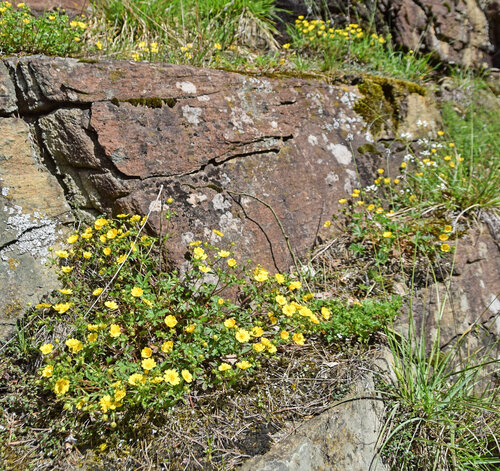
The rock outcrops are inhabited by endangered species, such as the Alpine cinquefoil (Potentilla crantzii subsp. serpentine). © Hana Pánková
Opening up the vegetation
As part of habitat management, we started with removing self-seeding woody plants. In younger pine stands up to 40 years old, we opened up the vegetation significantly, creating smaller gaps or glades in places. During the course of the project, it became evident that cutting alder buckthorns (Frangula alnus) led to its rapid regrowth, so it was pulled out manually. As opening up primarily targeted the lower vegetation layers in the stand, its overall impact was not very high (up to 15%). At sites with a deeper soil horizon, stand opening led to the expansion of the Wood small reed (Calamagrostis epigejos), Purple moor-grass (Molinia caerulea), and the Black bent (Agrostis gigantea). As a result, mowing and woodland grazing by sheep were subsequently introduced there. The second issue associated with opening up was moss layer development. In the peri-Alpidic pine woodlands on steep south-facing rocks, we abandoned further opening up because it became evident that serpentinite species were suffering from drought due to prolonged dry conditions and high temperatures. In the context of expected climate change, it is advisable to support natural regeneration of Scots pines (Pinus sylvestris) in these areas as it would at least partially provide shade.
Topsoil removal and soil chemistry restoration
At sites where the serpentinite horizon was covered by a thicker layer of humus or vegetation, it was necessary to remove the layer to restore the soil’s chemical properties and patterns. To protect the tree root systems, a combination of manual scraping and mechanical scraping with an excavator was used. Monitoring results showed that if the humus layer is not completely removed down to the serpentinite soil horizon, or if only small areas (2 × 2 m) are scraped, the site is quickly colonised by ruderal species. Serpentinite vegetation has developed gradually on the scraped areas. Initially, early successional species develop there, with dominance of the Annual meadow-grass (Poa annua), Scarlet pimpernel (Anagallis arvensis), and the Self-seeding spruce (Picea). In the second and third years, tall grasses and common meadow species dominate, such as the Tufted hair-grass (Deschampsia caespitosa), Hop trefoil (Trifolium campestre), and the Common bird’s-foot trefoil (Lotus corniculatus). Examples of forest species or forest edge species include the Common dog-violet (Viola riviniana) and the Common centaury (Centaurium erythraea). Stable serpentinite vegetation begins to establish itself by the fourth year after scraping, with dominant species such as the Alpine cinquefoil, Sheep’s fescue, and the Field wood-rush (Luzula campestris).
Mowing and woodland grazing
In the stands with tall grasses, mowing was initiated twice a year, followed by woodland grazing (only in the NNM). A comparison between mowed and unmown areas showed that mowing has the greatest impact on reducing the red grass coverage and decreasing the amount of old grass. The impact on black bent was initially minimal, which may be due to its good vegetative reproduction; however, it is now almost absent from the site. Additionally, a reduction in the occurrence of self-seeding woody plants was observed there. The suppression of alder buckthorn was, however, achieved through manual uprooting; after mowing, it would quickly regrow. Mowing had a positive effect on typical species of calcareous pine forests, such as the Blue moor-grass, Sheep’s fescue, Lady’s bedstraw (Galium verum), and the Alpine pennycress. A slight positive impact was also observed on the Serpentine knautia. At the same time, mowing led to an increase in the amount of moss at the site.
Grazing took place only between 2019 and 2021 with a small number of sheep, so no significant difference in vegetation composition was observed between grazed and mown areas. However, a difference was recorded in moss layer coverage, where areas with higher sheep presence showed the creation of bare patches without vegetation.
Restoration of forest stands
A major issue has been high pressure from forest game animals (the Fallow deer Dama dama and the Roe deer Capreolus capreolus), which almost entirely prevents natural regeneration of the pine forest. Therefore, it was necessary to install protective fencing around young growths. Key to the pine forest restoration on serpentinites is to proceed in small areas of 2–5 ares to prevent excessive opening up, which leads to the immediate expansion of species such as the Wood small reed. This approach is more akin to restoration in beech or fir forests. This comes at the cost of poorer regeneration of young pines due to less light. However, this allows serpentinite plant species to become established at the edges and gradually in the centre, almost from the beginning of restoration, while expansive species do not spread into the older stands.
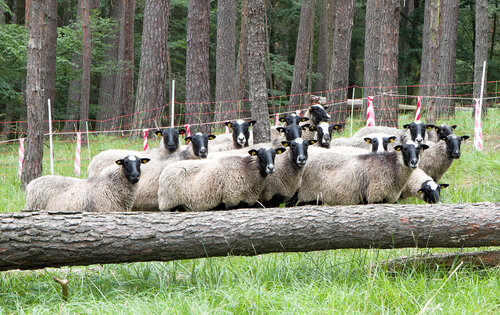
In the past, the forests were used for grazing, which kept the vegetation open. For this reason, woodland grazing is also the primary management approach in the area. © Czech Union for Nature Conservation Vlašim Local Chapter archive
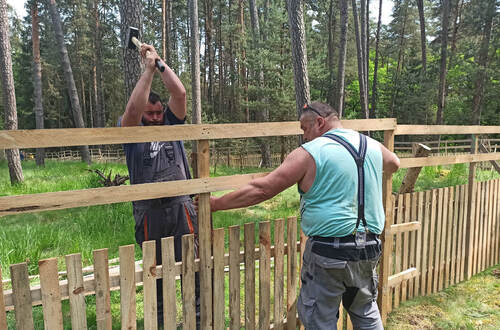
Due to strong pressure from forest game, sites for both natural and artificial forest regeneration need to be enclosed within fencing. © Hana Pánková
Detailed and accurate management is essential
The restoration of serpentinite pine forests in the Dolní Kralovice serpentinites took place both within the NNM (according to the Management Plan) and outside the Specially Protected Area (commercial forest). In both types of areas, a combination of opening, mowing, and woodland grazing was used along with the removal of the upper soil horizon. The aim was to unify the management approach across the entire serpentinite area. Thanks to good cooperation with the landowners, the unification has been successful.
The results of monitoring the impact of management measures have shown that their planning must consider broader contexts, including climate change. Although serpentinite species require an open canopy, we do not recommend opening up on south-facing slopes. Opening up the canopy also increases the risk of wood small reed expansion, and must therefore be followed by mowing or, ideally, grazing. One of the key measures – whether to support serpentinite species or natural forest restoration – is the removal of the upper soil layer. These measures, however, need to be implemented decisively so that the exposed patches are large enough and not rapidly overgrown by vegetation. However, serpentinite species spread slowly, so their occurrence in the target areas can only be expected from the fourth year onwards. It is therefore important to create a varied mosaic of habitat conditions as habitat patches at the site, from which both trees and serpentinite species can benefit. To support serpentinite species, it is advisable to establish these exposed patches outside of pine mast years and before the first seeds ripen. In contrast, if our aim is natural pine restoration, it is best to scrape the soil in a mast year before seed dispersal. A major issue is browsing by forest game animals, which primarily focus on herbs while avoiding coarse grasses such as fescues, oat-grasses, and reed grasses. As a result, some serpentinite species, including the sandwort species Minuartia smejkalii, are unable to produce seeds at certain sites, leading to a significant decline in their populations. Game animals also hinder forest restoration, making it necessary to fence off all stands. ■
The project Support for Endangered Serpentinite Species is funded by the EEA/Norway Grants 2014–2021 – Programme CZ-ENVIRONMENT, reg. no. 3201200005.
- - - -
Cover photo: Peri-Alpidic pine woodland in the Hadce u Želivky National Nature Monument is characterized by a high occurrence of lichens. © Hana Pánková
- - - -
The list of references is attached to the online version of the article at www.casopis.ochranaprirody.cz

